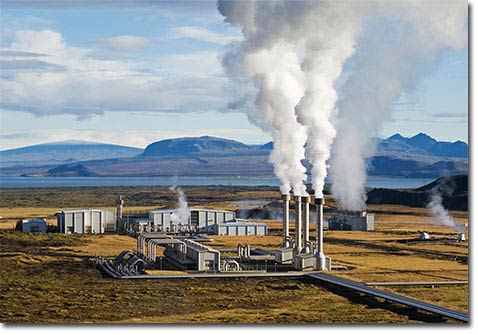Escalating investment in geothermal power could result in a 134% increase in global geothermal capacity between 2010 and 2020, from 10.7 gigawatts (GW) to 25.1 GW, under a high-growth forecast scenario, according to a report by Pike Research. Under a more conservative business-as-usual forecast scenario, Pike estimates that geothermal power capacity could increase 34% to 14.3 GW by 2020.
The current installed capacity of 10.7 GW is spread across 26 countries with a combined output of approximately 67 terawatt hours (TWh) of electricity. Currently, the United States is the global geothermal leader with 3.1 GW of installed capacity, and seven countries represent 88% of the world market. While conventional geothermal resources account for nearly all online capacity today, enhanced geothermal systems (EGS) and co-produced wells both offer opportunities for expansion outside of rift zones or volcanically active regions throughout the world, according to the study.

Pike Research’s high-growth forecast scenario assumes a continued increase and persistent volatility in the price of oil, tightening carbon regulations, improved access to capital, standardization of geothermal exploration data, contribution from EGS-enabled and co-produced resources, technological breakthroughs in exploration and drilling equipment, improved access to drills and skilled labor, and sustained policies supporting renewable energy mandates, grants, and tax subsidies.
Pike forecasts that total US geothermal capacity will reach 4.2 gigawatts (GW) in 2020, a 36% increase from the 2010 level and significantly more than any other country. That would represent almost 30% of total worldwide geothermal power capacity of 14.3 GW in 2020.
Asia Pacific will achieve the highest capacity among world regions, with 5.9 GW of geothermal power—41% of worldwide capacity. Under a more aggressive growth forecast scenario, Pike says, total worldwide capacity could reach 25.1 GW by 2020.
Geothermal remains an underutilized resource, representing only a small fraction of the global renewable energy portfolio today. Currently the vast majority of capacity is concentrated in just seven countries, but additional support from global financial markets and enhanced regional cooperation by institutions such as the World Bank and ARGeo, in Africa, will drive the development of new capacity in promising markets such as Kenya, Indonesia, and Turkey.
The world’s total installed geothermal capacity in 2010 was 10.7 GW. Pike Research estimates that, at a minimum, 190 GW of conventional geothermal resource—equivalent of 225 to 250 nuclear power plants—are exploitable using current technology. While conventional geothermal resources account for nearly all online capacity today, enhanced geothermal systems (EGS) and co-produced wells both offer opportunities for expansion outside of rift zones or volcanically active regions throughout the world.
Pike Research’s report, Geothermal Power, analyzes the global market opportunity for electricity production from conventional, EGS, and co-produced geothermal resources. The study includes an examination of market drivers, existing and emerging technologies, the public policy and regulatory environment, and key industry players. Global market forecasts, segmented by geography, extend through 2020 and include profiles of key countries actively developing geothermal power projects.
Source: greencarcongress
 Follow
Follow